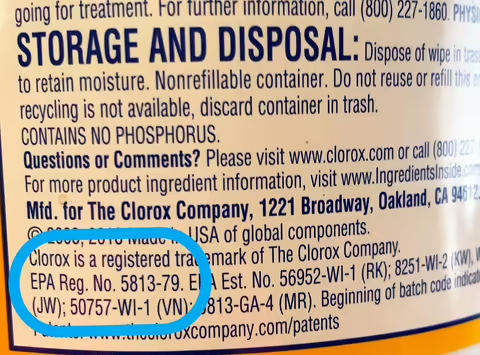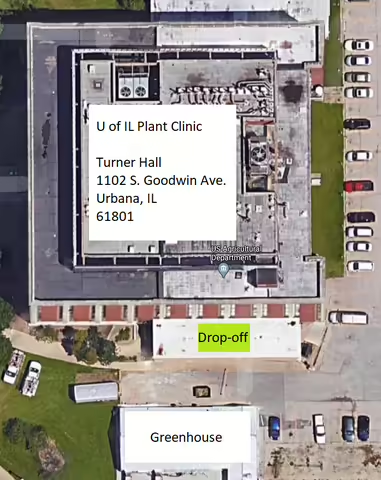
COVID-19 Effects on Illinois Pesticide Applicator Training, Testing, and Licensing
**Updated with a link to the new workbook on 4/16/20.
Listen to the audio version of this article
The impact of the COVID-19 (novel coronavirus) continues to create uncertainty and concern both globally and here in our community. Following Centers for Disease Control and Prevention (CDC) guidelines, the University of Illinois has implemented social-distancing protocols that impact all university events. Illinois Extension, as the outreach program of the university, aligns with all policies related to public health and safety.
The Pesticide Applicator Training and Testing Clinics jointly administered by the Illinois Department of Agriculture (IDA) and University of Illinois Extension Pesticide Safety Education Program (PSEP) are cancelled for the remainder of the clinic season (through May). Refunds will be issued as soon as possible.
For those currently licensed, but needing to retest: The Illinois Department of Agriculture will extend licenses that expired on December 31, 2019 until December 31, 2020. If license verification is required, contact IDA at AGR.CLM@illinois.gov or (217) 785-2427.
For those who are unlicensed and would like to become an operator for 2020: Due to the special circumstance, non-certified applicators (operators) will not have a testing requirement for the remainder of 2020. Operators must continue to work under the direction of a certified applicator and receive general pesticide training. The supervising applicator must be certified in each category applicable to the pesticide use. A training option is this video, Agricultural Worker and Handler Pesticide Safety Training at https://vimeo.com/215241678.
For those NOT currently licensed and still needing to test in either General Standards or any category: All in-house testing has been suspended. IDA is offering online testing for a limited number of exam categories. To request and register for an exam, please carefully follow the instructions at https://www2.illinois.gov/sites/agr/Pesticides/Pages/online-testing.aspx. Please note that these exams are being offered in response to the COVID-19 pandemic. IDA has stated that all individuals who take an online exam to receive a temporary license will be required to re-test in 2021.
For those who still have licensing and testing questions: Please consult IDA’s FAQ site at https://www2.illinois.gov/sites/agr/Pesticides/Pages/Cancellations-FAQ.aspx.
For those who need training: PSEP offers several online trainings that can be used for individual study. For those preparing for the General Standards exam, the Private Applicator course online can serve as a substitute. **A new workbook created for this purpose in English only is now available.** Registration is required and the fee is $15. For more information, visit www.pesticidesafety.illinois.edu.
For those who need study materials: Manuals and workbooks are available for order at pubsplus.illinois.edu. Shipping delays will likely occur due to the shelter in place mandate and restrictions in campus mailing. We are currently unable to accept publication orders through the Pesticide Safety Education Program's website.
Training and testing opportunities will be available at a later time, once stay at home restrictions are lifted. We are already starting on the 20-21 training and testing season schedule. Please consult the University of Illinois PSEP Facebook Page for up-to-date information regarding training and testing.
Help with Selecting Disinfectants for COVID-19
By Maria Turner
Listen to the audio version of this article
In general, disinfectants control a wide range of pathogens that are or could be a problem on hard, porous and/or nonporous surfaces. These pathogens may include; Staphylococcus aureus, Salmonella enterica, Escherichia coli (commonly known as E. coli), and even some strains of the flu. Some pathogens are known problems; some are not likely to be an issue; and others are emerging and therefore have been unavailable to study. In the midst of the novel coronavirus pandemic, we are turning to disinfectants for help, but how do we know if they are effective?
The U.S. Environmental Protection Agency (EPA) registers disinfectants for use and, as such, classifies pathogens into three tiers: small non-enveloped viruses, large non-enveloped viruses, and enveloped viruses. According to EPA, corona viruses are enveloped viruses, which is the easiest tier of virus to kill with the appropriate disinfectant product. The criteria for that classification is based on how the three types are inactivated by disinfectant. When an emerging viral pathogen is identified, a disinfectant manufacturer has to provide evidence to EPA that their particular product can be effective against the pathogen if they wish to make pesticidal claims against that pathogen.
Normally, in order for a product to endorse a claim to kill a pathogen, it must first prove its ability to be effective against the known pathogen with extensive scientific research, which takes considerable time. In the case of an emerging pathogen, time is of the essence. The EPA offers guidance to registrants on the required criteria when making claims on emerging pathogens not previously listed on their label. This guide, “Emerging Viral Pathogen Claims for SARS-CoV-2: Submission Information for Registrants” can be found at: https://www.epa.gov/pesticide-registration/emerging-viral-pathogen-claims-sars-cov-2-submission-information-registrants. The provisions allow manufacturers to be able to request an amendment to the label by proving that the disinfectant has provided efficacy against harder-to-kill pathogens. (For example, Rotavirus is harder-to-kill than SARS-CoV-2). The EPA reviews the claim to determine its safety and then can approve the claim, thus allowing the manufacturer to make off-label claims to the public. The scientific testing will still need to be conducted and submitted to EPA, but this expedited process can be used to get something in place immediately.
As many products are coming to market, the EPA has been helping manufacturers work through the amendments and create a list of products that can be used against SARS-CoV-2, the novel coronavirus that causes COVID-19. EPA is referring to this list as “List N”. When purchasing a product, consumers can check the EPA registration number to see if it is included on the list and will therefore be effective against COVID-19. This list, found at: www.epa.gov/pesticide-registration/list-n-disinfectants-use-against-sars-cov-2, is being updated frequently. The label and table images below are provided as an example of what to look for. Again, refer to the website for an up to date list.
In List N, the column that reads “Follow the directions and preparation for the following virus” shows Rotavirus, and the question might be asked, why doesn’t it say SARS-CoV-2? This column lists either viruses that are another type of human coronavirus similar to SARS-CoV-2 or viruses that are harder-to-kill than the human coronavirus. EPA allows both. Be sure to note the next column over. Pay close attention to the contact time, which is the amount of time the surface should be visibly wet, which is listed in minutes.
Before making your final selection and heading to the check out, be sure to fully read the directions for use on the product’s label. Special attention should be given to the contact time on the surface that is treated so there is full effectiveness. Carefully follow all label directions. If a product is not on the list, it has not been qualified for use against COVID-19. Remember that disinfectants are pesticides and the label is the law. For additional information about using disinfectants effectively with steps to reduce your risk while using them, check out http://npic.orst.edu/ingred/ptype/amicrob/covid19.html.
References:
https://www.epa.gov/coronavirus
https://www.epa.gov/newsreleases/epa-releases-list-disinfectants-use-against-covid-19 (March 5, 2020)
https://www.ncbi.nlm.nih.gov/pmc/articles/PMC4369385/
https://www.cnn.com/2020/02/26/health/lysol-clorox-coronavirus-disinfectants-trnd/index.html
University of Illinois Plant Clinic Operations during COVID-19
Listen to the audio version of this article
The University of Illinois Plant Clinic is currently open and accepting samples. The Plant Clinic is running on a reduced staff in accordance with social distancing guidelines. As a result, fewer staff are in the lab and they have a reduced ability to return phone calls. They ask that clients please send an email, which can be replied to by staff members even when they are not present in the lab. However, if a client does not have access to email, they are welcome to call and leave a voicemail with their question and contact information, and a staff member will call them back when they are able.
Submitting samples
Samples can be submitted by mail or dropped off at the Plant Clinic with slight changes in procedure:
Mail Samples:
- Please use USPS to ship samples and email the Plant Clinic with the tracking number, if there is a tracking number. Mail is currently arriving once or twice per week, but low numbers of samples are being submitted so they are being processed very quickly.
- If UPS or FedEx are used, clients MUST provide a tracking number. Neither UPS or FedEx are currently delivering to the building so Plant Clinic staff have to go pick up packages (they won’t know to expect a package without a tracking number).
Drop-off Samples:
- Samples can be left in a large, green, drop-off box located at the south doors of Turner Hall (opposite the greenhouse). A map of the drop-off location is pictured below. Sample submission forms and pens are available in the box. The box is checked daily.
University of Illinois Plant Clinic Contact Information
Website: https://web.extension.illinois.edu/plantclinic/
Email: plantclinic@illinois.edu
Mailing Address:
University of Illinois Plant Clinic
S-417 Turner Hall, 1102 S. Goodwin Ave.
Urbana, IL 61801
Phone: 217-333-0519
Dicamba Resource Available
By Maria Turner
Listen to the audio version of this article
The Pesticide Safety Education Team has updated the reference guide for applicators who will use Dicamba on soybeans. Knowing that planting is approaching quickly this year, it is crucial to now become familiar with the requirements before it is time to spray and you find yourself in a time crunch. Read the label closely and follow the additional state restrictions. Remember the last application of Dicamba on soybeans is June 20th or 45 days after planting or after R1 and there is a V4 cut off for Tavium. There is also a temperature restriction. Do not apply if the air temperature at the time of application at the field is over 85 degrees F or if the National Weather Service forecasted high temperature for the nearest available location for the day of application exceeds 85 degrees F. Wind speed and wind direction can impact the application. If you use a wind meter, take a picture of the mph reading on the screen, so that you can use this for your label required record sheet. Please check out the link to the resource (
).
2020 Fungicide Table Available for Corn and Soybeans
By Maria Turner
Listen to the audio version of this article
The 2020 fungicide efficacy tables for corn and soybeans are now available at the Illinois Field crop disease hub. These tables allow producers to study individual trials that have been done by plant pathologists across the United states for fungicides in corn and soybeans. There have been several additions in products and new diseases as well, including Tar Spot in corn. This can be a valuable tool for your 2020 growing season.
Download This Issue of the Newsletter
Download, save, and share the 2020 March/April issue of the newsletter.
Editorial Notes
The development and publication of this newsletter has been supported with funding from the Illinois Department of Agriculture.
Michelle Wiesbrook, Extension Specialist, Pesticide Safety Education
The Illinois Pesticide Review is published six times a year. For more information about pesticide safety or for more issues of this newsletter, please visit us at www.pesticidesafety.illinois.edu. You can also reach us at 800-644-2123.
Disclaimer: Mention of trade names in this newsletter is for general information purposes only and does not constitute endorsement of one product over another, nor is discrimination intended against any product.
Copyright © 2019, Board of Trustees, University of Illinois
We’re on Facebook! Follow us for updates on programs, news, and events.



